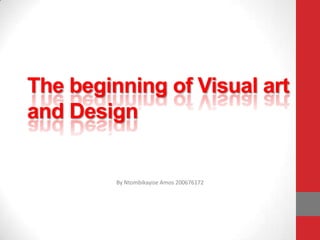
The beginning of visual art and design
- 1. The beginning of Visual art and Design By Ntombikayise Amos 200676172
- 2. Why are the arts important? • They are languages that all people speak that cut across racial, cultural, social, educational, and economic barriers and enhance cultural appreciation and awareness. • They are symbol systems as important as letters and numbers. • They integrate mind, body, and spirit. • They provide opportunities for self-expression, bringing the inner world into the outer world of concrete reality. • They offer the avenue to "flow states" and peak experiences. • They create a seamless connection between motivation, instruction, assessment, and practical application--leading to deep understanding. • They are an opportunity to experience processes from beginning to end.
- 3. Why the arts… • They develop both independence and collaboration. • They provide immediate feedback and opportunities for reflection. • They make it possible to use personal strengths in meaningful ways and to bridge into understanding sometimes difficult abstractions through these strengths. • They merge the learning of process and content. • They improve academic achievement -- enhancing test scores, attitudes, social skills, critical and creative thinking. • They exercise and develop higher order thinking skills including analysis, synthesis, evaluation, and "problem-finding." • They are essential components of any alternative assessment program. • They provide the means for every student to learn By Dee Dickinson
- 4. WHY DO PEOPLE MAKE ART? • RELIGIOUS ART • ART FOR THE DEAD • ART AND NATURE • FUNCTIONAL ART • ART FOR ARTS SAKE
- 5. RELIGIOUS ART • Seated Buddha Akshobhya (?), the Imperturbable Buddha of the East, 9th–10th century Tibet Gilt copper; H. 22 13/16 in.(57.8 cm) • Page from an Illuminated Gospel, early 15th century Ethiopia, Lake Tana region Wood, vellum, pigment; H. 16 1/2 in. (41.9 cm)
- 6. ART FOR THE DEAD • Statue of Demedji and Hennutsen, ca. 2465–26 B.C.E.; early Dynasty 5; Old Kingdom Egyptian Rogers Fund, 1951 (51.37) • Triumph of Dionysos and the Seasons Sarcophagus, ca. 260–270 Roman Phrygian marble; H. 34 in. (86.4 cm)
- 7. ART AND NATURE MAYA LIN "The Wave Field," 1995. Shaped earth; 100 x 100 feet. University of Michigan, Ann Arbor, Michigan
- 8. FUNCTIONAL ART • Jacket, ca. 1616 British; Made Great Britain linen, silk, metal; L. at center back: 16 ½in. (42 cm). Rogers Fund, 1923 (23.170.1) • Kiki Smith. (American, born Germany 1954). 1995. Artist's book, page (irreg.): 13 x 9" (33 x 22.9 cm). Edition: 2,500. Publisher: Pace Wildenstein, New York. Printer: Diversified Graphics, Minneapolis.
- 9. The Elements of Design are: • • • • • • Line Shape and Form Value Color Space Texture
- 10. Line The path of a point moving through space is a line. Lines may be explicit (right, Matisse) or implied (left, Hopper)
- 11. Shape & Form Shape implies form and is perceived as 2dimensional (below, Twombly), while form implies depth, length, and width and is perceived as 3-dimensional (right, Michelangelo)
- 12. Color All of the colors are derived from the three primary colors (red, blue, and yellow) and black and white. Color has three properties: hue, value, and intensity (right, Ojibwe beadwork)
- 13. Value Value refers to the relative level or darkness or lightness of a color in terms of contrast (left, Raphael)
- 14. Texture The tactile (touchable) qualities of an object, actual or implied (right, Bernini and left, Rauschenberg)
- 15. Space & Perspective Space is the area in which art is organized. Perspective is representative of volume of space or a 3-D object on a flat surface (above, Escher, right, Da Vinci)
- 16. The Principles of Design are: • • • • • Movement and Rhythm Balance Proportion Variety and Emphasis Harmony and Unity
- 17. Pattern Pattern is the repetition or reoccurrence of a design element, exact or varied, that establishes a visual beat (left, Warhol and above, Klimt)
- 18. Rhythm & Movement Rhythm or movement is the suggestion of motion through the use of various elements (above, Pollock, and right, an unknown artist, India)
- 19. Proportion & Scale Proportion is the size relationship of parts to a whole and to one another. Scale is to relate size to a constant, such as a human body (left, Serra, below, a woman adds tiny details to a Pueblo plate).
- 20. Balance Balance is the impression of equilibrium in a pictorial or sculptural composition. Balance is often referred to as symmetrical, asymmetrical, or radial (above, a photo of a flower, and to the right, Copley)
- 21. Unity Unity is achieved when the components of a work of art are perceived as harmonious, giving the work a sense of completion (left, Hokusai, below, Manet)
- 22. Emphasis Emphasis is the created center of interest, the place in an artwork where your eye first lands (left, Toulouse-Lautrec, above, O’Keeffe)
- 23. The Principles of Design in Review The Principles of Design are the ways that artists use the Elements of Art to create good Compositions (artwork) Balance Contrast Emphasis Variety Unity/Harmony Proportion Rhythm Movement Pattern Repetition
- 24. REFERENCES • Adapted from Project ARTiculate’s Elements & Principles of Art http://www.projectarticulate.org • Presented by: bruceblackart.com • Presented By Mrs. Cole : The Elements and Principles of Design • Principles of Design for the Artist : BRUCEBLACKART.COM • http://www.brigantine.atlnet.org/GigapaletteGALLERY/websites/ARTicul ationFinal/MainPages/LineMain.htm • http://www.brigantine.atlnet.org/GigapaletteGALLERY/websites/ARTicul ationFinal/MainPages/LineMain.htm
